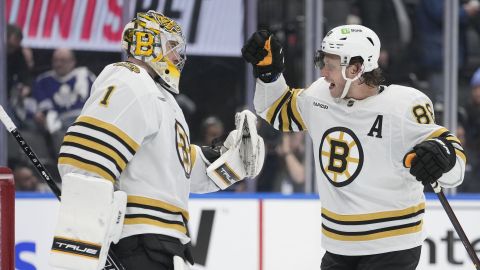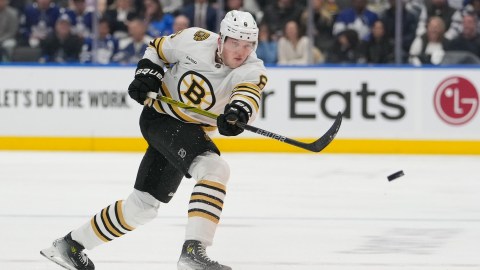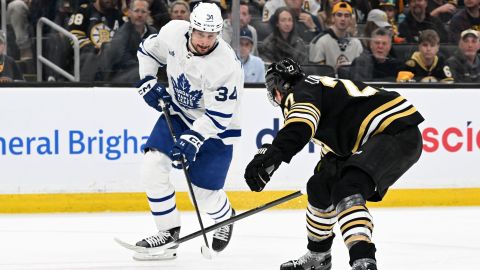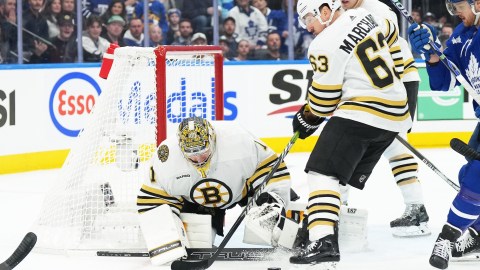There's no one, specific reason, other than it's the greatest game on the planet. Twelve world-class athletes giving 100 percent effort while standing atop centimeters-wide skate blades on a sheet of ice providing nonstop action for 60 minutes.
There's nothing on this planet that can even compare.
Maybe you most enjoy watching small, skilled forwards pick corners, or you like goalies making spectacular glove saves, or bone-crunching hits along the boards, or the old-fashioned scrap at center ice. It's irrelevant. What matters is that you love the game, and you probably love all of it.
But what happens when a crucial element of that game comes under question? What if that essential component of the sport is believed to endanger the very men who play that sport for a living?
Can you just take it away? And if you can, will that make anything better?
That's the problem facing the NHL and the NHLPA right now, after three deaths of enforcers in the last four months and four player deaths overall this year. Wade Belak took his own life last week. Rick Rypien battled depression before he committed suicide in August, as well. Tom Cavanagh was found dead in his car in January, his death believed to be the result of suicide. Derek Boogaard died in May after mixing alcohol with oxycodone. We'll never know if he did it intentionally, but he was recovering from a concussion, the third reported head injury of his career, at the time.
The four deaths have called a lot into question (as did the recent findings in Bob Probert's death), but the fact that Belak, Rypien and Boogaard all had similar jobs as "tough guys" has brought the focus on fighting and physicality.
"The game is a physical, violent game," said former Bruins tough guy Lyndon Byers on WEEI on Friday. "There's going to be a worst-case scenario. My point to you is, it's amazing, I think, that there's not more Wade Belaks, Derek Boogaards, Rypiens."
Former enforcer Georges Laraque, who carved out a 12-year career in the league due to his toughness, shared a similar concern.
"I could give you about 20 names of people that have demons still because of that job," Laraque told CBC News.
That thought is one that's becoming widespread across the hockey world in the wake of these recent tragedies. And really, it's not a movement that just started with these deaths. Concussions have gone to the forefront of hockey (and football) fans' minds in recent years, as their devastating effects on the human body become more and more understood. Anyone who's followed Marc Savard's long battle with post-concussion issues knows that all too well. Rules are being put in place to protect players' heads in both sports, but high-speed contact is inherently built in to the game.
In hockey's case, it's even more so, due to the fact that there are men employed solely to get into fistfights with other men. Their opponents often have the very same job description. And these men are worshipped.
In Boston, you need look no further than Shawn Thornton. The 34-year-old tough guy is one of the most well-respected athletes in a sports-obsessed city, and he's earned every bit of it. He takes skate blades to the face and barks at the opposing team on his way off the ice, he fights the other team's toughest guy just days after getting stitches on his own face, he sparks his team by playing with reckless abandon and he was a key contributor to the team that ended a 39-year championship drought in Boston.
"Look at this guy," we all say. "Doesn't have half the talent of the other nine guys on the ice, but he's got three times the heart."
The city, quite simply, loves Thornton, and he's embraced the city right back.
If it weren't for fighting, though, it's unlikely at best that Thornton would be playing in the NHL. Ask Bruins fans if that's a scenario they'd like to imagine. I think you know the answer.
Then again, ask them if they are OK with players dying extremely young, in their late 20s or early 30s, perhaps as a direct result of that style of play. The issue gets more difficult.
The thing is, we all respect the hell out of guys who are just tougher than we can imagine. Lose a tooth? No big deal. That's the mind-set. Gash your face open? Stitch it up, miss a shift, get back out there. Concussion? Until recently, that wasn't even a word in hockey.
You've just been dinged up, son.
Shake out the cobwebs and hop back over the boards.
We need you. You're a warrior.
These are hockey players, right? Well, yes, but they're also human beings, fathers, sons, brothers, cousins, uncles and friends. Role players have to skate their lanes off the ice, too.
That's where the NHL and NHLPA comes in. The league, for all its faults and mistakes in this decade alone, does not want its players to die. The NHLPA does not want its members to die. The players do not want to die. Both the league and the players association have a tremendous need to learn more to protect the men on the ice, but the science of the brain will never be absolute. The scientific data will always leave some room for questioning.
The physical evidence, however, is simply too staggering to ignore.
"We are committed to examining, in detail, the factors that may have contributed to these events, and to determining whether concrete steps can be taken to enhance player welfare and minimize the likelihood of such events taking place," the NHL and NHLPA said in a joint statment. "It is important to ensure that every reasonable step and precaution is taken to make NHL players, and all members of the NHL family, aware of the vast resources available to them when they are in need of assistance. We want individuals to feel comfortable seeking help when they need help."
It's true that players battling depression or any other mental health issue might need that help, but right now, it's the league and NHLPA that needs help.
Do they change the fabric of the sport based on studies that can never provide a definitive answer to their questions? Do they err on the side of caution, even if it means they may be changing the game to be "too" safe?
Do they remove the instigator penalty? And if they do, does that make things better or worse?
They can't do anything, but whatever they do will almost certainly cause some sort of negative effect. The enforcers will be jobless — is that any better? The fans may not like this new game. The players may not be able to adjust after playing the game a certain way their whole lives. The very essence of what makes hockey great could begin to melt.
This isn't a problem that's new. Fans, writers, executives, coaches and players have debated the merits of fighting's place in the game forever, and many have called for an outright ban. But those that know hockey know that such a ban would hardly solve anything, as dangerous hits could be dished out with no fear of repercussion. No matter the changes that have been proposed or will be proposed, there is always opposition, and there's no way to guarantee player safety.
This also isn't a problem that's exactly fixable. In this problem, for everyone involved, there's just no easy way out.



